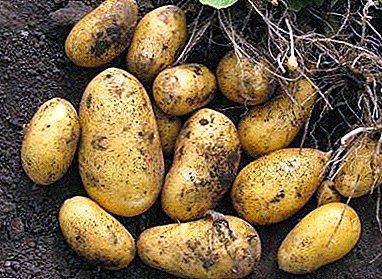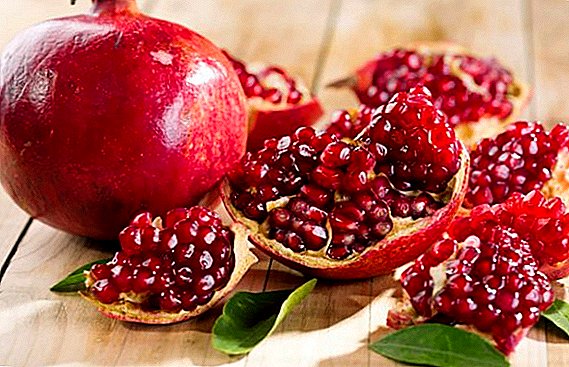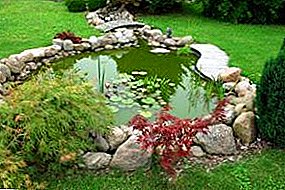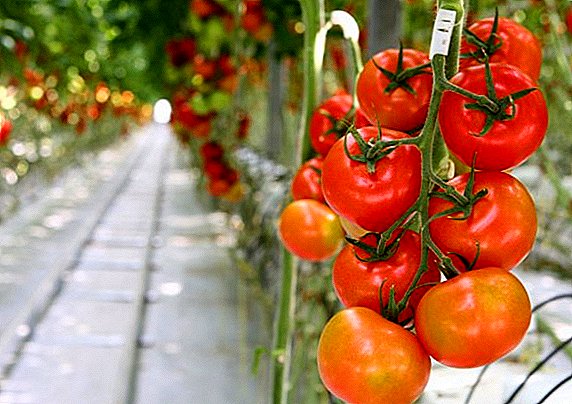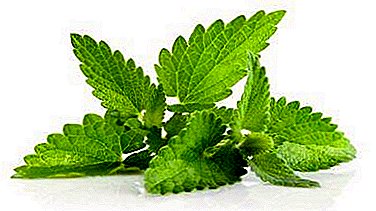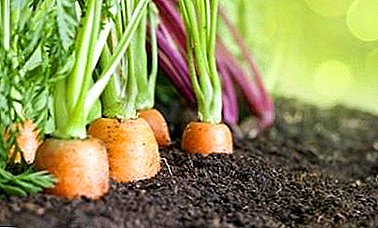
Carrots - garden crop, demanding to growing conditions. A big harvest can be obtained even from one bed, if you properly prepare a place for planting.
An important parameter of the soil is its composition. In the emaciated area, the carrot grows shallow and tasteless.
Before sowing seeds, it is necessary to determine the type of land, to carry out measures to improve its quality.
Why do I need training?
During the autumn digging insect pests are on the surface and die in winter. Fertilizing and liming acidic soil will help grow a rich and tasty crop.
Seeds of carrots sprout better in loose soil. To root grow smooth, you need to carefully clean the area from debris.
When to start?
Land for planting carrots begin to prepare in autumnwhen the garden season is over. In the spring, work on the selected site is started 10-14 days before sowing the seeds.
Soil parameters
When choosing a site for carrots, you should consider the following soil parameters:
- density;
- acidity;
- fertility.
Chemical composition
Optimum acidity of soil for carrots - neutrali.e. with a pH in the range of 6.5-7.0. It is allowed to grow orange vegetables in slightly acidic soil. The humus content should not be less than 4%.
Mechanical composition
 Carrots are best sown in loose sandy or loamy soil. It should not contain stones, large lumps and roots. The ideal soil density for carrots is 0.65 g per cm3. In light ground, which includes a sufficient proportion of sand, the roots are sweet and juicy. When growing vegetables in heavy soil yield is significantly reduced.
Carrots are best sown in loose sandy or loamy soil. It should not contain stones, large lumps and roots. The ideal soil density for carrots is 0.65 g per cm3. In light ground, which includes a sufficient proportion of sand, the roots are sweet and juicy. When growing vegetables in heavy soil yield is significantly reduced.
Clay is not suitable for planting carrots. It forms a dense crust, which prevents seed germination. Shoots will be weak and uneven. In soil with a high content of clay water stagnates, which leads to decay of root crops.
Step-by-step instructions for preparing the soil in the garden
Before sowing carrots, it is necessary to determine the type and humidity of the soil, its acidity.
Determination of soil type
Determine the type of soil can be a simple folk method. To do this, a handful of soil is slightly moistened with water, trying to make a ball, then roll it into a sausage and a bagel. After the done manipulations evaluate the result:
- The clay soil is plastic, lends itself well to modeling and keeps its shape.
- Ball and sausage are easily obtained from loam, and cracks are formed on a donut. It may decay. If the loam is light, the sausage shape will not work.
- It is impossible to make a ball from sandy soil, but a lump well rolls into a thin string.
- Sandy soil crumbles into the palms.
- The black "fat" print, which leaves the soil on the palm after squeezing it into a fist, is a sign of black soil.
Methods for determining the acidity
Acidity of the soil is determined using a special device. - pH meter. You can use other reliable methods.
Litmus paper
 To determine the acidity of the soil, specialty stores sell kits that include a color scale and strips soaked in reagents. To get indicators, you need to perform a number of actions:
To determine the acidity of the soil, specialty stores sell kits that include a color scale and strips soaked in reagents. To get indicators, you need to perform a number of actions:
- Dig a hole 35 cm deep. Collect 4 samples of soil from the walls, fold them into a glass container and mix.
- Moisten the soil with distilled water in a ratio of 1: 5. Wait 5 minutes, then immerse the litmus strip in the mixture for a couple of seconds.
- Compare the resulting color on paper with a scale of pH values.
Appearance
You can judge the pH level of the soil by its appearance. plot. A number of signs testify to increased acidity:
- whitish surface of the earth;
- water in the grooves with a rusty tint;
- brown precipitate in place of absorbed moisture;
- rainbow film on the surface of the puddle.
Typical plants
Each site has its own weed. To learn what kind of land certain plants like, the table will help:
| Earth acidity | Growing plants |
| Neutral | Quinoa, nettle, red clover. |
| Alkaline | Poppy, field bindweed. |
| Weak acid | Coltsfoot, thistle, clover, alfalfa, mountaineer, wheatgrass, woodlouse, burdock. |
| Sour | Horse sorrel, starlet, horsetail, plantain, creeping buttercup, moss, nursery, sedge, fragrant bell, protruding belous, mint, cornflower, tricolor violet. |
Use vinegar
The soil acidity is determined using the following national method:
- A test copy of the earth is placed on a glass surface and poured over with 9% vinegar.
- Evaluate the result: rapid foaming indicates an alkaline medium, moderate - about neutral, and the lack of reaction - about acid.
How to recognize the level of humidity?
 Excess moisture causes rotting of root crops, washes valuable minerals from the soil, impairs its breathability. To protect planting carrots from such effects, before sowing seeds determine the soil moisture.
Excess moisture causes rotting of root crops, washes valuable minerals from the soil, impairs its breathability. To protect planting carrots from such effects, before sowing seeds determine the soil moisture.
Gardeners use a tensiometer, an electrical resistance sensor or a household moisture meter. You can do without the device using the simple method: dig a hole 20 cm deep, get a handful of earth from the bottom and squeeze tightly in your hand. Depending on the results, draw the appropriate conclusions:
- soil crumbled - humidity not more than 60%;
- fingerprints remained on the ground - about 70%;
- the lump falls apart when lightly pressed - within 70-75%;
- moisture appeared on a piece of soil - more than 80%;
- the lump is dense enough and leaves a wet print on the filter paper - about 85%;
- moisture oozes out of compressed soil - 90% or more.
How to make the soil for planting better?
Land preparation for carrots includes the following activities:
- In the autumn, the plot is cleared of weeds. After 2 weeks, they dig it to a depth of 25-30 cm, removing stones and rhizomes. As a disinfectant use 3% Bordeaux liquid, oxyfine or 4% solution of copper oxychloride.
- Spring soil loosened or re-dig. Then the surface is leveled with a rake.
- Digging the plot, make the necessary fertilizers.
- In spring, the prepared bed is watered with a mixture consisting of 1 tsp. copper sulphate, 1 cup of mullein, 10 liters of warm water.
- After sowing the seeds, the furrows fall asleep and slightly compacted. Then the beds are covered with plastic wrap to retain moisture and heat. Shelter is removed when the first shoots appear.
Seasonal rate of feeding can be divided into 2 times: half to make in the fall, and the rest - in the spring. Fertilizers are chosen depending on the type of soil.
Loamy
Sand is not introduced into light loamy soil.. To increase its fertility per 1 m2 make such fertilizers:
- 5 kg of humus or compost;
- 300 grams of wood ash;
- 1 tbsp. superphosphate.
Chernozem
During the autumn digging in the black soil at 1 m2 make the following components:
- 0.5 buckets of old and fresh sawdust;
- 2 tbsp. superphosphate;
- 10 kg of sand.
Fresh sawdust must be moistened with a solution of mineral fertilizers.
Clay and podzolic
 In the fall, clay and podzolic soil is ground by dolomite flour or chalk: for every m2 make 2-3 tablespoons. any means. At high clay content, fertilizers containing humus will be required. In the spring, in order to increase the fertility of the soil, while digging for 1 m2 add such substances:
In the fall, clay and podzolic soil is ground by dolomite flour or chalk: for every m2 make 2-3 tablespoons. any means. At high clay content, fertilizers containing humus will be required. In the spring, in order to increase the fertility of the soil, while digging for 1 m2 add such substances:
- 2 buckets of peat and river sand;
- 10 kg of humus;
- 3-5 kg rotted wood sawdust;
- 300 grams of ash;
- 1 tbsp. superphosphate;
- 2 tbsp. nitrofoski.
Sandy
Sandy soil fertilized with a nutrient mixture:
- 2 buckets of turf land with peat;
- 1 bucket of humus and sawdust;
- 1 tbsp. nitrophosphate and superphosphate.
This volume is designed for 1 m2. During sowing of seeds, it is recommended to add wood ash, which will prevent the development of fungus, provide seedlings with beneficial substances.
Sour
If you plan to sow carrots on a plot with acidic soil, you must first treat it with fluff at the rate of 1 cup per 1 m2. It can be replaced with wood ash, chalk, or dolomite flour.
Peat
Before planting carrots in peat soil for 1 m2 add the following components:
- 5 kg of coarse sand;
- 3 kg of humus;
- clay bucket;
- 1 tsp sodium nitrate;
- 1 tbsp. superphosphate and potassium chloride.
Possible mistakes
Inexperienced gardeners during the cultivation of carrots can make such mistakes:

- In case of violation of the concentration of nitrogen-containing fertilizers carrots grow tasteless, bitter.
- When using fresh manure shoots may be affected by rot.
- If you make a lot of organic matter, the tops will actively develop, and the roots will turn out "horned" or crooked. Harvest quickly deteriorates.
- Growing carrots on acidic soil, get sweet fruit will not work.
- If during the preparation of the land does not remove the stones, the roots will grow curves.
- It is impossible to simultaneously apply lime and fertilizers, since they neutralize each other's actions.
- Failure of crop rotation leads to lower yields due to depletion of the soil. Onions, cabbage, pumpkin and solanaceous crops are considered good precursors for carrots. You should not grow root vegetables after parsley or beans. Re-carrots return to the site after 4 years.
Carrots are not demanding to care, but sensitive to the chemical and mechanical composition of the soil. To get a rich harvest, you need to know in what soil it is better to plant, and properly prepare the selected site. First, determine the type of soil, in accordance with which conduct autumn and spring training. In order not to harm the roots, you should follow the recommended dosage.


